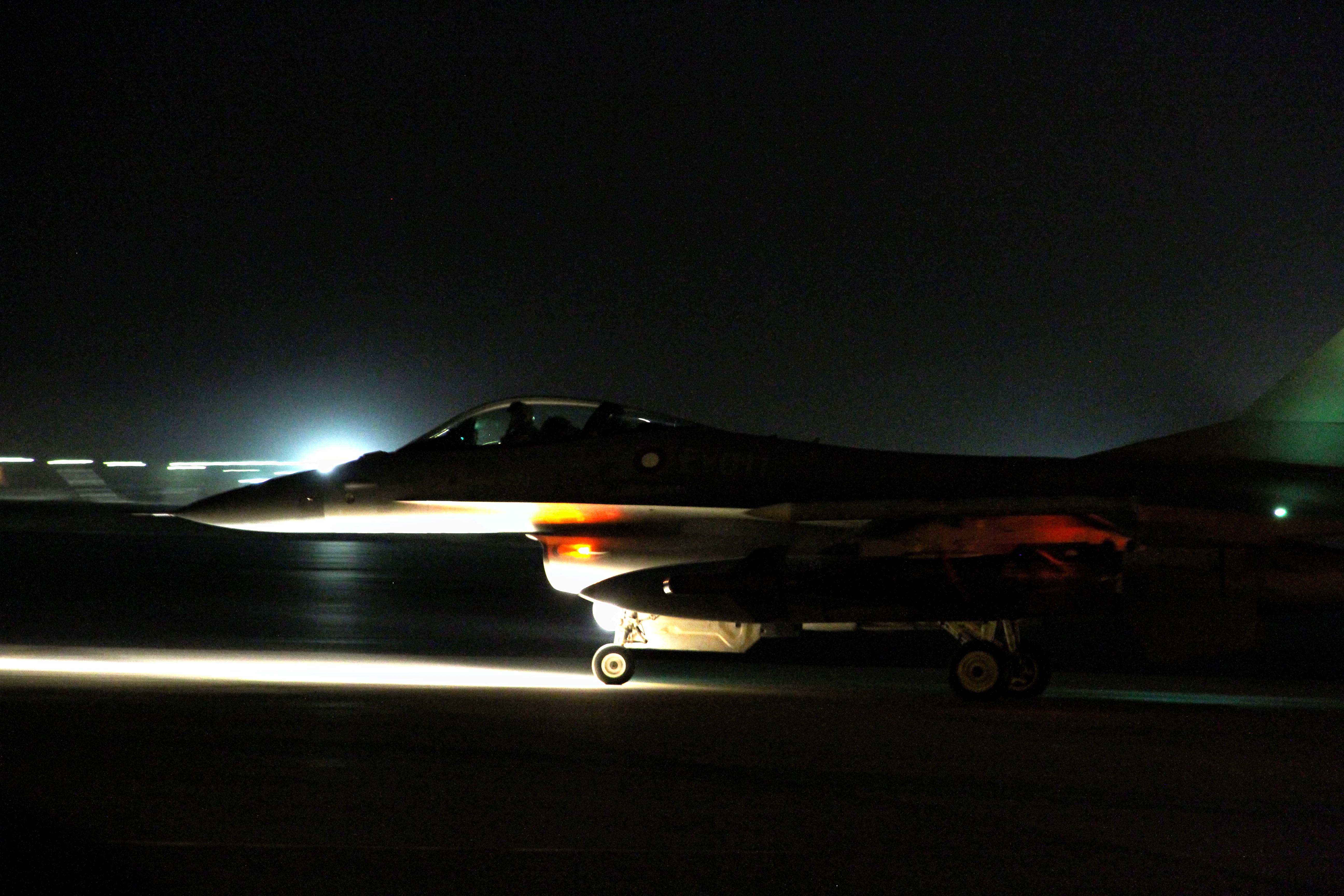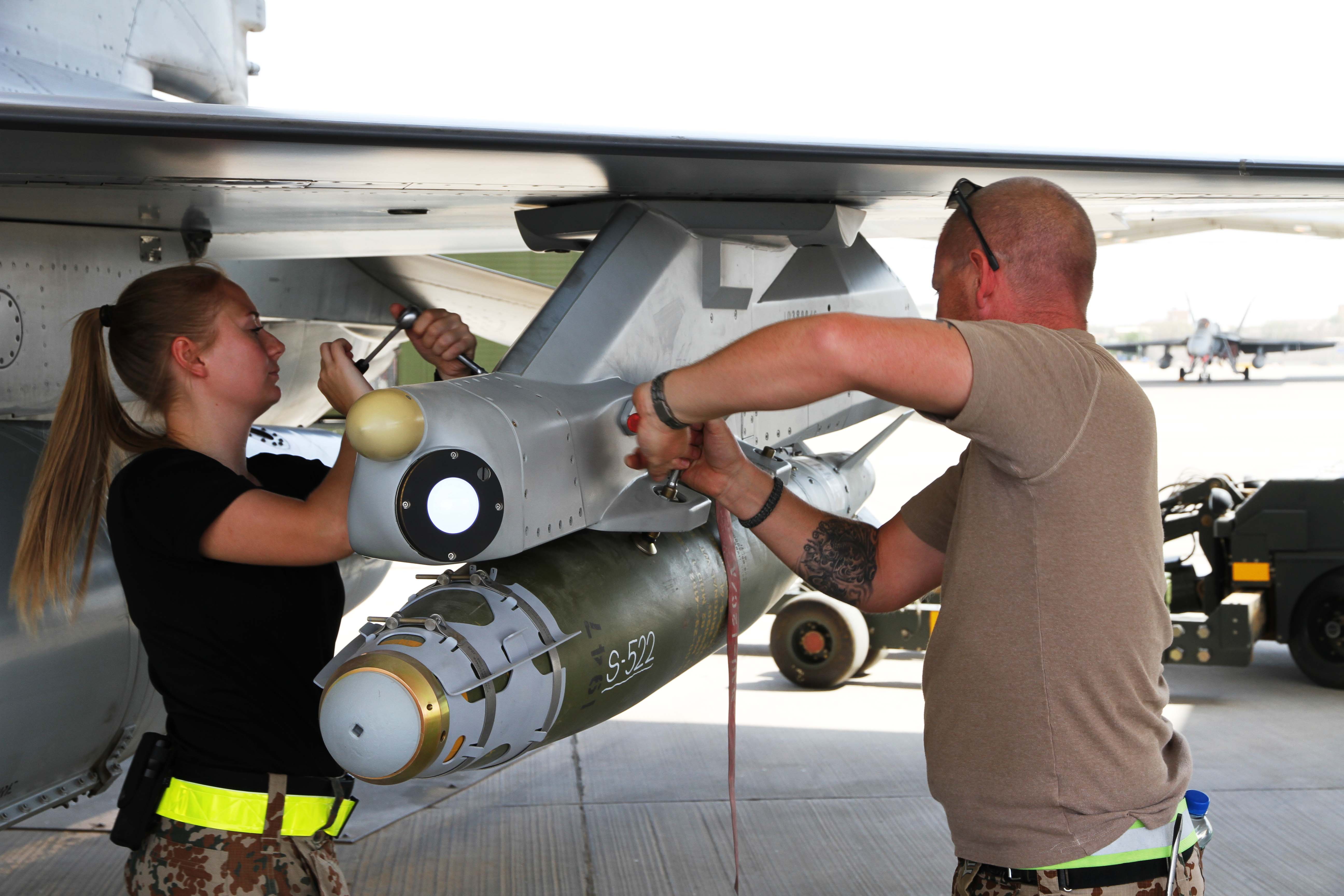Denmark was one of the last international allies to join Coalition strikes against Islamic State in Iraq. Even so, the past year has seen such a heavy workload that Danish personnel went public with their complaints of fatigue. With all seven F-16s now safely home, guest reporter Rasmus Raun Westh looks at a year of strikes – and a battle to force Denmark to be more transparent on where it bombs.
On the night of September 29th-30th, heavily-armed Danish combat aircraft took off from Ahmed Al Jaber Air Base in Kuwait for their last missions against Islamic State.
[pullquote]Danish aircrew and ground support personnel were finally coming home after 547 missions and 503 bombs dropped. [/pullquote]Four F-16s – each armed with two 2,000 pound bombs – would participate in a larger mission with the US Air Force. Another pair of F-16s took off later that same night, but returned with their bombs still attached, Middle East correspondent Puk Damsgård later reported from the base.
Their missions completed, Danish aircrew and ground support personnel were finally coming home after 547 missions and 503 bombs dropped.
Denmark formally joined the war against Daesh on October 2nd 2014, when the Folketing (Parliament) – in a near-unanimous vote – authorized the deployment of 140 Air Force personnel to Kuwait and 20 more to Coalition headquarters in Qatar. Another 120 Army personnel have been carrying out training missions in Iraq’s Anbar province, and the Kurdistan Regional Governorate.
Initially delayed by a lack of permits to operate in Kuwaiti air space, Danish fighter jets took off on their first mission on October 16th.

A Danish F-16 takes off on its last combat mission over Iraq, September 29 2015 (Danish MoD/Ronny Rasmussen)
Despite political intentions to extend the mission mandate into a second year, the seven F-16s were pulled home following a public appeal from overworked flight mechanics reportedly suffering illness and high absence rates.
During a visit to Denmark shortly before the withdrawal agreement, US Chairman of the Joint Chiefs of Staff General Martin Dempsey – citing a need for Denmark to be able to stay in the anti-Daesh war in the long run – endorsed the temporary withdrawal while encouraging the Danes to rejoin the fight “at the appropriate time”.
In place of the F-16s, the Danish Air Force is sending an AN/TPS-77 transportable radar to Ayn al-Asad Base in Anbar province, reportedly in response to a US request for a radar capable of replacing two AWACS surveillance aircraft currently flying over Iraq and Syria.
Vi trækker syv F16-fly hjem. Men kampen mod IS fortsætter, bl.a. med træningsbidraget i Irak. #dkpol
— Carl Holst (@CarlHolst) August 22, 2015
Denmark’s then-Defence Minister announces end of F-16 mission
Transparency issues
In a series of articles penned by this author for Dagbladet Information, Danish MPs and others have heavily criticized Denmark’s military for its lack of transparency in its war against Daesh.
The first Danish strikes coincided with a change in the wording of press releases sent out by US Central Command. Prior to the Danish engagement, CENTCOM’s summaries would include lines like “the United Kingdom and the Kingdom of the Netherlands aircraft participated in these airstrikes.”
As of October 21st 2014 however, “out of respect for participating nations“, CENTCOM now left it up to individual countries to identify their role in airstrikes.
In its own first mission update on October 20th, Danish Defence Command informed the public that its F-16’s had flown “11 missions in Iraq” and that the fighters had “used bombs in connection with some of the missions”. There was no mention of which locations had been struck, or on which dates.
“You shouldn’t be able to track one specific attack in one specific area back to a Danish plane. We prefer to hide in the crowd,” Colonel Søren W. Andersen said in an interview with Dagbladet Information – a policy later defended by General Peter Bartram, head of the Danish military.
Colonel Andersen confirmed that the Danish military had asked CENTCOM not to identify Danish actions in its press releases, though argued that the introduction of the ‘partner nation’ term was a result of “several interests that had to be united” rather than a Danish request exclusively.
[pullquote]We prefer to hide in the crowd”
Spokesman Colonel Søren W. Andersen, justifying Denmark’s decision to refuse to say where it bombs[/pullquote]A FOIA request by Danish reporter Charlotte Aagaard later confirmed the Danish policy of rendering it impossible to identify Denmark’s role in strikes, “neither directly or by through deduction”, specifying that “the Danish contribution should not be mentioned in Coalition press releases if fewer than three nations are mentioned in relation to the activity in question.”
Under pressure from Danish media, mission updates were initially expanded in November to include the names of provinces and cities targeted – although dates and locations of attacks were still withheld. Three months later, Defence Command scaled back the level of geographic detail by omitting city names. And from March a caveat was added noting that strikes took place ‘primarily’ in e.g. Anbar province, thus leaving open the possibility of strikes elsewhere.
‘No civilian casualties’
Despite its reticence in saying where it bombs, Denmark recently set a new benchmark for Coalition transparency.
No Danish aircraft had featured in a recently declassified CENTCOM report on 45 alleged civilian casualty incidents in Iraq and Syria to April 30th. However in early September Danish Armed Forces announced they may have killed civilians during an Iraq air strike on Sunday August 30th.
Suspicions had been aroused during a post-strike video review, Colonel Søren W. Andersen told DR – and the strike was now the subject of a CENTCOM investigation. As a subsequent statement noted, “In certain parts of the video material, showing four people and a vehicle, actions are taken that could be considered as not openly hostile.”
In an announcement published on October 2nd, shortly after the last F-16 missions, Defence Command announced the CENTCOM investigation had found the strike “most likely” did not kill civilians, but that the four people targeted were “in the process of planting roadside bombs”.
“The Coalition has reviewed all accessible material from the attack. This includes, among other things, full video material of the attack from two Danish F16-planes; the pilots’ own observations; as well as other intelligence,” the statement read.
In keeping with its generally more secretive approach to warfare, Danish Defence Command has said it will publish only the report’s conclusions, and that the investigation itself will remain classified.
Return of the F-16s?
The war against Daesh still enjoys fairly wide support in the Danish parliament. Even with newly elected green party The Alternative joining the leftist Red-Green Alliance in the anti-war choir, seven out of nine parties have expressed support for a new mandate, including the provision of radar in Anbar province.
[pullquote]I am open to the idea, but I am not yet decided.”
Danish Foreign Minister Kristian Jensen on possible future deployments to Syria[/pullquote]Although newly appointed Foreign Minister Kristian Jensen has indicated a possible return of Denmark’s F-16s in the summer of 2016, no timescale has so far been set. In political interviews and parliamentary hearings, Jensen has also supported expanding the Danish mission into Syria following Canada, Australia and France’s recent lead.
“I am open to the idea, but I am not yet decided. We will decide once we redeploy our F-16s. Several things come into play here. One is our allies, another is that our troops are deployed with the backing of a strong and wide mandate,” Jensen has said.
The Foreign Minister’s apparent reticence may be an acknowledgement that the Socialist People’s Party – presently a backer of the mission – has expressed skepticism about bombing Daesh in Syria.


